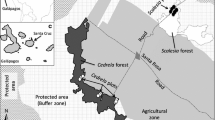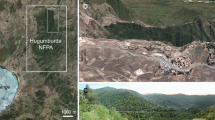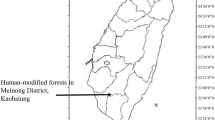Abstract
There is concern that secondary forests dominated by introduced species, known as novel forests, increase taxonomical similarity between localities and lead to biotic homogenization in human-dominated landscapes. In Puerto Rico, agricultural abandonment has given way to novel forests dominated by the introduced African tulip tree Spathodea campanulata Beauv. (Bignoniaceae). In this study, I characterized the tree species composition of S. campanulata forests in Puerto Rico as means to evaluate if biotic homogenization is occurring. Non-metric multidimensional scaling was used to examine what variables were related to the large (≥10 cm diameter at breast height [DBH]), small (≥2.5 to <10 cm DBH), and juvenile (<2.5 cm DBH) tree species composition of 20 sites. Species composition was strongly related to substrate properties, less related to land use history, and unrelated to spatial attributes. The introduced species component was low (mean = 17%, S.E. = 1.8) and compositional differences were mostly due to native tree species of secondary to old growth forests on equivalent substrates. Animals appear to disperse most species (86%) into these forests yet because of this some introduced species will persist. Although uncommon species were largely absent, recent species establishment is shaped by substrate properties making biotic homogenization in these forests unlikely. The S. campanulata forests of Puerto Rico facilitate native tree species establishment in lands where poor management practices extirpated the original forest. These results highlight the importance of remnant old growth forests or trees that act as seed dispersal sources and facilitate native species recovery in novel forests.



Similar content being viewed by others
References
Abelleira-Martínez OJ (2009) Ecology of novel forests dominated by the African Tulip tree (Spathodea campanulata Beauv.) in northcentral Puerto Rico. MS thesis, Universidad de Puerto Rico, Río Piedras
Acevido G (1982) Soil survey of Arecibo area of northern Puerto Rico. USDA Soil Consrervation Service and UPR, Mayaguez
Aide TM, Zimmerman JK, Pascarella JB et al (2000) Forest regeneration in a chronosequence of tropical abandoned pastures: implications for restoration ecology. Restor Ecol 8:328–338
Aragón R, Morales JM (2003) Species composition and invasion in NW Argentinian secondary forests: effects of land use history, environment, and landscape. J Veg Sci 14:195–204
Ashby WC (1972) Distance measurements in vegetation study. Ecology 53:980–981
Bawiec WJ, Krushensky RD, Shellekens JH (2001) Geology of Puerto Rico. USGS Open File Report 98-34
Birdsey RA, Weaver PL (1982) The forest resources of Puerto Rico. USDA Forest Service Southern Forest Experiment Station, New Orleans
Carlo TA, Collazo JA, Groom MJ (2003) Avian fruit preferences across a Puerto Rican forested landscape: pattern consistency and implications for seed removal. Oecología 134:119–131
Chinea JD, Helmer EH (2003) Diversity and composition of tropical secondary forests recovering from large-scale clearing: results from the 1990 inventory in Puerto Rico. For Ecol Manag 180:227–240
Cottam G, Curtis JT (1956) The use of distance measures in phytosociological sampling. Ecology 37:451–460
Cubiña A, Aide TM (2001) The effect of distance from forest edge on seed rain and seed bank in a tropical pasture. Biotropica 33:227–240
Di Rienzo JA, Balzarini M, Casanoves F et al (2003) Infostat statistical software. Universidad Nacional de Córdoba, Argentina
ESRI (1999) ArcView GIS 3.2. Environmental Systems Research Institute, Redlands, California
Ewel JJ, Whitmore JL (1973) The ecological life zones of Puerto Rico and the US Virgin Islands. USDA Forest Service Research Paper 18, ITF, Rio Piedras
Flynn DFB, Uriarte M, Crk T et al (2009) Hurricane disturbance alters secondary forest recovery in Puerto Rico. Biotropica 42:149–157
Foster JT, Robinson SK (2007) Introduced birds and the fate of Hawaiian rainforests. Cons Biol 21:1248–1257
Galanes IT, Thomlinson JR (2009) Relationships between spatial configuration of tropical forest patches and woody plant diversity in northeastern Puerto Rico. Plant Ecol 201:101–113
García Montiel DC, Scatena F (1994) The effect of human activity on the structure and composition of a tropical forest in Puerto Rico. For Ecol Manag 63:57–78
Grau RH, Aide TM, Zimmerman JK et al (2003) The ecological consequences of socioeconomic and land-use changes in post-agriculture Puerto Rico. Bioscience 53:1159–1168
Guevara S, Laborde J, Sánchez-Ríos G (2005) Los árboles que la selva dejo atrás. Interciencia 30:595–601
Haysom KA, Murphy ST (2003) The status of invasiveness of forest tree species outside their natural habitat: a global review and discussion paper. FAO UN Forestry Department Forest Health and Biosecurity Working Paper FBS-3E
Helmer EH (2000) The landscape ecology of tropical secondary forest in montane Costa Rica. Ecosystems 3:98–104
Helmer EH (2004) Forest conservation and land development in Puerto Rico. Landsc Ecol 19:29–40
Hobbs RJ, Arico S, Aronson J et al (2006) Novel ecosystems: theoretical and management aspects of the new ecological world order. Glob Ecol Biogeogr 15:1–7
Hubbell SP (2001) The unified neutral theory of biodiversity and biogeography. Princeton University Press, Princeton
Hutchinson J, Dalziel JM (1927) Flora of west tropical Africa. Royal Botanical Gardens, Kew, London
Lichstein JW, Grau HR, Aragón R (2004) Recruitment limitation in secondary forests dominated by an exotic tree. J Veg Sci 15:721–728
Liogier HA, Martorel LF (2000) Flora of Puerto Rico and adjacent islands: a systematic synopsis, 2nd ed. Editorial UPR, Puerto Rico
Little EL, Wadsworth FH (1964) Common trees of Puerto Rico and the Virgin Islands. USDA Agriculture Handbook 249, Washington DC
Little EL, Woodbury RO, Wadsworth FH (1974) Trees of Puerto Rico and the Virgin Islands. USDA Agriculture Handbook 449, Washington, DC
López TM, Aide TM, Thomlinson JR (2001) Urban expansion and the loss of prime agricultural lands in Puerto Rico. Ambio 30:49–54
Lugo AE (2004) The outcome of alien tree invasions in Puerto Rico. Front Ecol Environ 2:265–273
Mascaro J, Becklund KK, Hughes RF, Shnitzer SA (2008) Limited native plant regeneration in novel, exotic-dominated forests on Hawaii. For Ecol Manag 256:593–606
McCune B, Mefford MJ (1999) Multivariate analysis of ecological data (PC-Ord), version 4.25. MjM Software, Gleneden Beach, Oregon
McKinney ML, Lockwood JL (1999) Biotic homogenization: a few winners replacing many losers in the next mass extinction. Trends Ecol Evol 14:450–453
NOAA (2002) Monthly station normals of temperature, precipitation, and heating and cooling degree days, 1971–2000: Puerto Rico. Climatography of the United States No. 81 (66)
Novotny V, Miller SE, Leps J et al (2004) No tree is an island: the plant–caterpillar food web of a secondary rain forest in New Guinea. Ecol Lett 7:1090–1100
Olden J, Rooney TP (2006) On defining and quantifying biotic homogenization. Global Ecol Biogeogr 15:113–120
Picó F (1988) Historia general de Puerto Rico. Ediciones Huracán, Puerto Rico
Pimenta JA, Bianchini E, Medri ME (1998) Adaptations to flooding by tropical trees: morphological and anatomical modifications. In: Scarano FR, Franco AC (eds) Ecophysiological strategies of xerophytic and amphibious plants in the neotropics. Oecologia Brasiliensis vol. 4. PPGE-UFRJ. Rio de Janeiro, Brasil, pp 157–176
Ramos OM, Lugo AE (1994) Mapa de la vegetación de Puerto Rico. Acta Cientifíca 8:63–66
Rodríguez-Durán A (2005) Murciélagos. In: Joglar R (ed) Biodiversidad de Puerto Rico: vertebrados y ecosistemas. Editorial del Instituto de Cultura, Puerto Rico, pp 241–274
Rudel TK, Lugo MP, Zichal H (2000) When fields revert to forest: development and spontaneous reforestation in post-war Puerto Rico. Prof Geogr 52:386–397
Silander S (1979) A study of the ecological life history of Cecropia peltata L., an early successional species in the rain forest of Puerto Rico. MS thesis, University of Tennessee
Starfinger U, Kowarik I, Rode M, Shepker H (2003) From desirable ornamental plant to pest to accepted addition to the flora? The perception of an alien tree species trough the centuries. Biol Invasions 5:323–335
Van der Pijl L (1969) Principles of seed dispersal in higher plants. Springer-Verlag, Berlin
Vega-Castillo S, Cuevas E (2009) Frugivory in Puerto Rican Anolis lizards and its possible effects on seed dispersal in tropical dry and moist forests on karst. Paper presented at the External Scientific Advisory Committee Symposium, CATEC, University of Puerto Rico, Río Piedras, Nov 13, 2009
Wadsworth FH (1950) Notes on the climax forests of Puerto Rico and their destruction and conservation prior to 1900. Caribb For 11:38–46
Winter M, Schweiger O, Klotz S et al (2009) Plant extinctions and introductions lead to phylogenetic and taxonomic homogenization of the European flora. Proc Nat Acad Sci USA 106:21721–21725
Zimmerman JK, Pascarrella JB, Aide TM (2000) Barriers to forest regeneration in an abandoned pasture in Puerto Rico. Restor Ecol 8:350–360
Zimmerman N, Hughes RF, Cordell S et al (2008) Patterns of primary succession of native and introduced plants in lowland wet forests in eastern Hawaii. Biotropica 40:277–284
Acknowledgments
Ariel Lugo, Carla Restrepo, Elvira Cuevas, and Skip Van Bloem provided valuable advice through the development of this study. Olga Ramos provided assistance on GIS programs. Iván Vicéns, Dixon Irizarry Negrón, Carlos Marrero Otero, Jaime Díaz, and students of the ALACIMA summer camps of 2005 and 2006 provided field assistance. Frank Axelrod and Marcos Caraballo aided in species identification at the UPR Biology Department and Botanical Garden herbariums. Raul Macchiavelli, Carolina Monmany, Ramón Agosto, and Miguel Acevedo provided statistical advice. Mildred Alayón and Lia Sánchez provided kind logistic support. Two anonymous reviewers provided useful comments.
Author information
Authors and Affiliations
Corresponding author
Rights and permissions
About this article
Cite this article
Abelleira Martínez, O.J. Invasion by native tree species prevents biotic homogenization in novel forests of Puerto Rico. Plant Ecol 211, 49–64 (2010). https://doi.org/10.1007/s11258-010-9771-4
Received:
Accepted:
Published:
Issue Date:
DOI: https://doi.org/10.1007/s11258-010-9771-4




